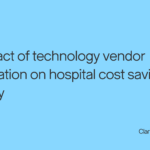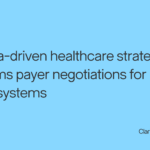Colin Hung from Healthcare IT Today sat down with Keith Florance, SVP, GM Payer Solutions at Clarify Health to discuss what is working to drive value-based transformation and where the industry can focus to accelerate the shift from fee-for-service to value. Watch the interview or read the transcript below to find out what Keith had to say. Colin Hung: Keith Florance: Colin Hung: Keith Florance: Colin Hung: Keith Florance: Colin Hung: Keith Florance: Colin Hung: Keith Florance: Colin Hung: Keith Florance: Colin Hung: Keith Florance: Colin Hung: Keith Florance: How can you do things that hold the provider harmless in some ways, but also give them the right nudges to do the right actions where once they come into a broader risk contract or any kind of risk arrangement, they’re actually already doing the right things? And so when I think about incentives, I think about how do you get an incentive in front of a doc tomorrow for the action that they did yesterday as opposed to contracts and value today that are like, “Okay, I’m going to do all this stuff for a year and then maybe 12 months later I’m going to learn the incentives that I got from performing all of my clinical care”, especially at the individual doc level. I may have no idea what I could have done or should be doing differently to be successful. And by that point, I’ve already been doing it for a whole year. And so that leads to the other part of it, which is the information and the ability to give a provider information about how are they performing more in real time as opposed to, again, at the end of this massive performance period and then getting incentivized on it after reconciliation months and months and months down the road. Colin Hung: Keith Florance: Colin Hung: Keith Florance: Colin Hung: Keith Florance: Colin Hung: Keith Florance: So for us, it’s being able to do that. And then I’ll keep coming back to this idea of provider engagement, but how do you use it to really case mix adjust for the panel that a provider has to show them that this is really about the patients that you are seeing and the drivers that are actually moving the needle on your panel when I look across a whole national provider base of performance? And so it’s both being able to identify those drivers and then being able to deliver it to a provider in a way where they can consume it. But without using the ML AI parts, we can’t really get a beat on understanding what are those measures. Colin Hung: Keith Florance: Colin Hung: Keith Florance: So in the past, you would have folks at a payer organization or at a provider organization doing manual queries across hundreds of different data sources to try to understand this stuff. But what we’ve done by being able to grant software access for real users to be able to harness the power of all of that data across all of those sources, it’s really magic, frankly, being able to take that and then, I will keep coming back to it again, but being able to use it to identify where you have unwarranted variation in care, and then being able to communicate it back to the provider so that they understand how to perform better in a value-based context. Colin Hung: Keith Florance: Colin Hung: Keith Florance: Colin Hung: This interview was originally published by Healthcare IT Today on their website and YouTube channel.
Hello and welcome to Healthcare IT Today. I’m Colin Hung, and we’re going to explore some pretty interesting topics today with Keith Florance, Senior Vice President and General Manager of Payers here at Clarify Health. We’re going to be talking about machine language, automation, payers and providers, and of course how we can help improve healthcare overall for patients. Keith, welcome to the program.
Thanks for having me.
Looking really forward to chatting to you about this. I’m pretty excited for this conversation. Let’s really start by talking about costs and healthcare outcomes. For the past decade, of course, we’ve been looking at trying to improve outcomes while reducing costs. And let’s be honest, we’ve been spending a lot more time focusing on the cost side of the equation. What are policymakers and healthcare leaders missing by only focusing on that side?
So yes, there has been a lot of focus on the cost side. The question is how much has it actually accomplished? And for me, one of the biggest drivers and reasons for that is because you can’t have the conversation on how to reduce cost with a provider directly and have that be the only side of the equation.
Okay.
Right? So if you want to get the behaviors, the engagement from providers, whether they be in fee for service or value, but you want to actually lower cost, you have to be able to talk to them about the clinical performance and quality performance measures that are really driving better outcomes. Right?
Okay.
And if you can frame it that way and you can frame it against what is also then going to drive costs, then you get real behavior change. And that’s ultimately what you want for both cost and outcomes.
Right. Because I think you explained it to me before we got on air, just asking someone to do something because it’s cheaper doesn’t always result in the behavior you’re wanting.
That’s right. That’s right. My mission is I always want to be improving both at the same time. And there’s ample opportunity to be able to do that. You just have to be able to deliver the information to the clinician in the right way and understand, again, what are those clinical measures that are going to create better outcomes that also drive an outsized component of affordability along with it?
Right. Because people aren’t slot machines. You don’t just kept plunk money in and get the results. There is an intrinsic motivation to help people. There’s other ways that you can encourage, and I think I agree with you, I think that’s been missing by only focusing on the cost side of that equation.
Absolutely. Yeah.
So you brought it up. Let’s talk about a little bit around this whole conflict, if you will, or the transition from, of course, a fee for service model and the value-based care model. I think, in general, people agree the fee for service model is not sustainable, it’s not tenable, and yet the momentum and the movement towards value-based care has been very slow despite the incentives and the encouragement. What do we need to do to maybe accelerate that a little bit?
So Colin, we could have had this conversation 15 years ago and we would still be in kind of the same place.
Okay. Okay.
It’s very frustrating, but there’s a lot of reasons for it. And frankly, there’s a lot of ways that you can fix that. And actually one of the ways that… I break it down into two parts. One part is actually around the incentives and how you’re using incentives in a way to create value-based behaviors that allow a more smooth transition into really being able to take on risks successfully.
I get it. So what I’m hearing is don’t try to change the world in one go-
No. Baby steps.
Help change the motivation in baby steps.
Yes. And do it doing ways, too, that you can actually alter even within a fee for service construct. So get them to do the types of things that are associated with success and value by applying our incentives on top of what they’re doing today at future service.
I really like that concept. I would challenge you, though, to say, how do we measure that? How do we show that progress? Because of course, the reason why we think that transition is going to be a big leap is because we want to show, “Look at all the great stuff we’ve done.” What you’re talking about is more sustainable and more achievable, but how do we measure those little micro improvements so that we don’t lose momentum?
Yeah. Well, I mean you aggregate them and you show them through the reporting and through actual engagement with the doctors on the actions that they’re taking and how those are driving the incentives. But to the point we made in the very first question, there’s the components around cost and incentives, and there’s also the components around outcomes and quality. And again, being able to use the incentives and show how they link back to the outcomes and quality as well, that’s the game changer for you. And you can see that over time and you can measure it over time to show them, here is how your performance has changed, here is how that would link to risk in the future as well.
Let’s change topics a little bit on you. I would say probably about five years ago when we were looking at these kinds of shows, the words AI, machine learning, ML, automation, they were sprinkled like pixie dust over everything. Everyone had it. Everyone was using it. But I really think it’s only been this year where we’ve really seen some tangible results from the proper application of these technologies. And we’re seeing these technologies in both the clinical side and the administrative side. In your opinion, what are some of the pain points that we really should be using these technologies to address in healthcare?
Well, the way that we think about that at Clarify is we have massive amounts of claims data. We have massive amounts of enrichment data, supplemental data, that goes along with that as well. And with all that data, the power that you have to understand what measures out of the hundreds of measures that you could choose are actually driving better outcomes. And there are some manual ways to think about that, ways to do it in Excel, but frankly, with this massive amount of data, machine learning and AI gives us the ability to really understand what are the top three things that are moving that particular quality metric or outcomes metric.
Let’s dive into that for a minute. Tell us a little bit about what Clarify health does, because one of the big things that I hear when I look at your company is that you’re really breaking down the barriers between payers and providers and really trying to motivate change in the industry. Tell us a little bit more about how you’re doing that.
Yeah. So one of the things is what we just talked about, the fact that we have this national data set of all the performance cross providers on nearly every patient in America.
Okay.
So what we’re able to do… Let’s say you’re a payer, right? You only have your own claims data to understand your member population. If you’re a health system, you only have your own clinical data from your HR systems. But we’ve been able to stitch all of this together. So when you have a new member, for instance, you have a better understanding of where that member is coming to you with. You have a better understanding of… If you actually are not even a payer or a health system at all, and this is the first time someone’s coming to you, we can actually tell you about that full patient journey. And then we can cohort that patient’s journey along with others that are similar to be able to tell a provider again, how is their performance stacking up against others that seen these types of patient journeys as well.
Keith, I want to thank you for being on the program, and I hope that a year from now when we get back together again, that we’re going to be talking about all these amazing progressions towards value-based care that we’re not seeing today.
I would love that conversation.
And before we go, where can people go to find out more information about Clarify Health?
I think you can just go to our website, clarifyhealth.com.
This has been Colin Hung at Healthcare IT Today. Check us out at healthcareittoday.com where you can get some amazing resources and insightful articles. Plus head on over to Twitter and follow us at #hitsm. I’m Colin, thanks for being here.
- Author Details





